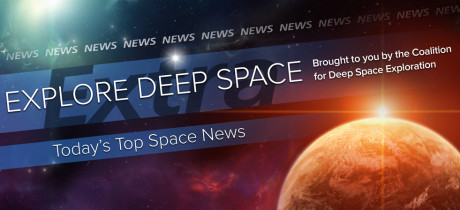In Today’s Deep Space Extra… President Trump expected to sign the NASA transition authorization act Tuesday morning which reinforces a focus on the human exploration of deep space and Mars.
Human Deep Space Exploration
Trump will sign the Mars-focused NASA bill Tuesday
Inverse.com (3/20): In a press briefing on Monday it was announced that President Trump will approve S442, the NASA transition authorization act. The bill increases NASA’s budget to $19.5 billion and directs NASA to focus on the human exploration of deep space and Mars. To that end, NASA is expected to test the Space Launch System and Orion in 2018, followed by a crewed mission to cis-lunar space in 2021.
Houston Chronicle (3/21): NASA has fared well in President Trump’s proposed 2018 budget, despite a near 1 percent overall decrease in proposed spending, the agency’s director of planetary sciences told the 48th Lunar and Planetary Science Conference Monday evening. Delivered to Congress on March 16, the first spending plan from the new Trump White House supports human deep space exploration and robotic planetary mission development, according to the agency’s Jim Green, who hosted a “town hall” session for planetary scientists.
SpaceX studying landing sites for Mars missions
Space News (3/20): SpaceX is working with NASA to identify landing sites for future human missions to Mars, company executive Paul Wooster explained in a presentation for planetary scientists gathered in Houston for the Lunar and Planetary Science Conference. Selection criteria include prospects for subsurface water ice and availability of solar power, according to Wooster.
Space Science
The Space Review (3/20): Proposed in 2013, NASA’s Asteroid Redirect Mission (ARM) struggled to find a niche in NASA’s Journey to Mars among outside experts and lawmakers. Last week, the Trump Administration issued its fiscal 2018 federal budget blue print. ARM was cancelled, leaving its future in doubt as the White House and Congress sort through budget issues that date back to a 2017 spending plan that was not adopted by Congress. ARM would robotically extract a boulder from the surface of an asteroid and steer it into orbit around the moon, where NASA astronauts launched aboard the Space Launch System and Orion crew exploration capsule would visit in the mid-2020s.
Europe’s ExoMars spacecraft begins lowering its orbit
Spaceflightnow.com (3/20): The European Space Agency’s ExoMars’ mission orbiter, the Trace Gas Orbiter (TGO), part of a bid to find evidence of life on Mars, has entered the aerobraking phase of its mission. The braking is intended to lower the altitude of TGO, which is seeking sources of methane gas in the thin Martian atmosphere. One source of methane is biological activity. The low point of TRO’s trajectory is to descend from 120 to 70 miles. TGO maneuvered into Martian orbit last October.
Mysterious water-like streaks on Mars might be sand flows instead
New Scientist (3/20): Discoveries and characterizations of Recurring Slope Linae on Mars raised hopes among scientists that the seasonal streak-like markings on sloped terrains were evidence of underground water or moisture in the thin atmosphere condensing. Instead, they may be streams of sand set in motion by sunlight on the planet’s surface.
Low Earth Orbit
China selects 80 proposals for future space science missions
GB Times, of Finland (3/17): China’s National Space Science Center corrals 80 science mission proposals for execution on future missions. Their themes range from astronomy and planetary science to biology investigations.
Launch of OA-7 Cygnus mission slips to NET March 27
Spaceflight Insider (3/20): Plans for the launch of Orbital ATK’s seventh NASA contracted resupply mission to the International Space Station have slipped from Friday to no earlier than March 27 so that United Launch Alliance can address a ground support hydraulic system issue, according to a ULA statement.

